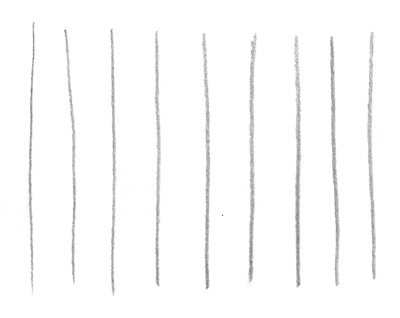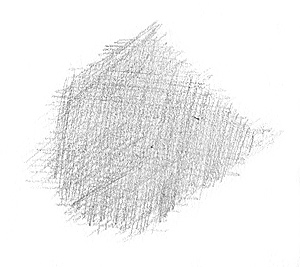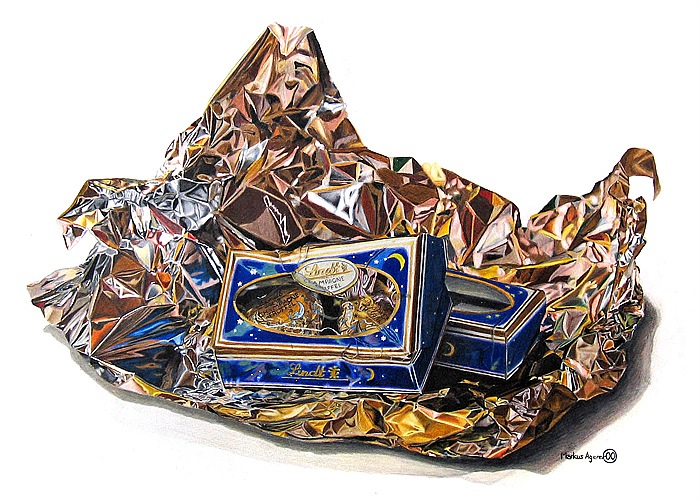When drawing, the following drawing instruments are available: point, line, area, and the tonal values (light and dark). These drawing instruments are used to create a drawing using the appropriate drawing technique and the appropriate drawing tool. The most common drawing tools are graphite pencil, ink pen, charcoal and crayons.
On this page you can learn more about the different drawing techniques:
Point and line are the basic drawing instruments. The line marks the outline of a motif. It is used as a basic technique for drawing, to represent the boundaries and the outline of objects. With it, contrasts can be depicted and pointed out. In addition you can also use the point as an drawing instrument.
The clear outlines of a flower, a chair or a tree are visible by drawing lines. Shadows, for example, in a mountain landscape, or strong wrinkles in a face can be represented by the line and the point without any shading. In the area of contemporary art, borders are blurred, but the line is also the typical characteristic of a drawing in modern non-representational drawings.
The most commonly drawing tools to use are pencil or graphite pen, ink pen, charcoal and crayons.

Here is a typical example how to use the line as a drawing instrument: Drawing a simple representation of a mountain:
.jpg)
The hatching is a classic drawing technique which makes it possible to draw and form the surfaces of a motif. Various effects can be achieved with the hatching technique. A good spatial effect results from the hatching, as well as different tonal values can be realized. If all gradations of a single color are used, a plastically representation of the motif is created.
Thin lines are drawn in the drawing technique "hatching". The direction of the lines usually runs at an oblique angle to the primary outline. In the case of a pure drawing, these shading must not be drawn too tightly, or even be smudged. This would already cross the line to painting, which is characterized by a areal painting technique. However, today the boundaries are fluid.
Another drawing technique is cross hatching. With this drawing technique two or more sets of hatchings are drawn over each other. This allows the artist to achieve many great effects when drawing. The line strength remains the same, but the use of this drawing technique results in shading in all variations. By drawing the lines of the hatching closer or farther to each other countless tone gradations become visible. If you want to draw in color (for example, with colored pencils), you can create many new hues by cross hatching in different colors.
Here are three types of hatching:

In the hatching from the picture above you can still recognize the individual lines. If the lines are concentrated, they become almost invisible. This makes a drawing more realistic because it is not immediately apparent at first glance that it was drawn. In an extreme case, you can also draw a photo-realistic image. The figure below shows a clearly denser hatching.

When smudging, a hatched area is blurred with a finger or a wipe tool. This makes it possible to create very smooth surfaces and tone gradients. Absolutely suitable for smudging is charcoal - it can be blurred so easily. But also pencil and crayons are suitable for this drawing technique. Ink, on the other hand, cannot be blurred.
For drawing with smudging technique you can use either a finger or a tool like cotton wool, a cloth, cotton swab, eraser, brush or paper wiper (or tortillion).
With the smudging technique you operate already at the border from what is described as drawing. When the hatching is blurred no single line or point is visible, which removes the original basic of a drawing.
.jpg)
If shading or tinting is to be achieved with liquid drawing materials, for example when drawing with ink, the wash is the technique of choice. With an brush you can wash ink over you line drawing to create a shading. This method comes from watercolor painting. You start with the lighter tonal values and work your way forward to the darker values. Anyone working on drawings with watercolor paints achieves a harmonious effect. The transparency of these colors means that the drawing does not look as if it has been dyed afterwards, but that there are fluid transitions between surfaces and lines.
Many artists combine the different methods of drawing and painting. They move along the borders between classical painting and drawing techniques and vary materials, techniques and procedures. Ink, combined with charcoal drawings, the combined use of graphite and pastel chalks, pencil drawings that are washed with ink, all these examples show the creative diversity that modern drawing techniques can offer. The use of watercolor paints or the creation of sparkle lights by opaque white in the drawing is also a classic way to combine drawing techniques.

The combined technique used in drawing and painting also includes the fact that in the field of painting a drawing no longer serves as a preparatory work The drawing contributes to the direct design of the painting. Furthermore, the methods of collage, the techniques with wet brush and the sgraffito stand for the combination of different artistic techniques.
This drawing technique receives its name sgraffito from the Italian verb sgraffiare, which means to scratch. This historical technique of wall styling was used mainly in Italy in the 16th century. Various color layers were applied and handled. Sgraffito is one of the stucco techniques. Other scratching techniques associated with applied color layers are also referred to sgraffito.
This website is about how to draw and paint. You will learn to use pencil and brush and how to drawn and paint your own pictures.